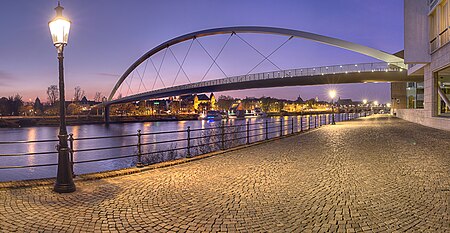Hoge Brug
Bridges in MaastrichtBridges over the MeuseCyclist bridges in the NetherlandsDutch building and structure stubsEuropean bridge (structure) stubs ... and 3 more
Netherlands transport stubsPedestrian bridges in the NetherlandsSteel bridges in the Netherlands

The Hoge Brug (Dutch for "high bridge", also known by its Maastrichtian dialect name: Hoeg Brögk) is a pedestrian and cycle bridge that spans the Meuse (Dutch: Maas) in Maastricht, Netherlands.
Excerpt from the Wikipedia article Hoge Brug (License: CC BY-SA 3.0, Authors, Images).Hoge Brug
Maasboulevard, Maastricht
Geographical coordinates (GPS) Address External links Nearby Places Show on map
Geographical coordinates (GPS)
| Latitude | Longitude |
|---|---|
| N 50.8462 ° | E 5.6973 ° |
Address
Hoge Brug
Maasboulevard
6211 EZ Maastricht
Limburg, Netherlands
Open on Google Maps









